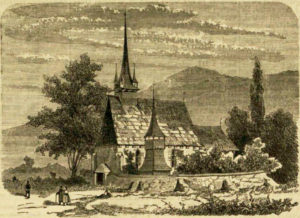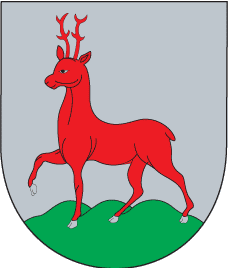Visk

Visk (Вишковo) can be found in the Subcarpathian Region, in Ukraine. The village is just 20 kilometers from Huszt. It is famous for its fortified church but also there are the ruins of its old fortification on the top of the hill overlooking the village. Recently, unique medieval murals from the beginning of the 15th century have been revealed in the church which was built in 1270 by King István V.

It was this Hungarian king who gave the village of Visk to Master Mykov (Mikó) and Chepán (Csépán) of the Hont-Pázmány Clan, the sons of Marchaleus in 1271. They were the ancestors of the Ujhelyi family. The inhabitants were mainly Saxon Germans at that time. Soon, the village became part of Máramaros County, and King László IV, as well as King András III, confirmed the family’s ownership.

However, the Ujhelyi family returned the property to the king in 1300, as the monarch had requested. In exchange for it, they received the villages of Rakasz, Fekete-Ardó, and Nyírtelekpuszta in Ugocsa County. It meant that the king wanted to own the settlement for a particular reason. It was the period when the church was rebuilt in the Gothic style. The church was surrounded by a wall, and there were four towers guarding it.

Also, there was a fortification belonging to the settlement, it was built by Mikó and Csépán, the sons of Martelus between 1281 and 1298. The ruins of this castle can be found on the hill over Visk. It was first mentioned in a document in 1299, then it became the property of King András III in 1300. The reconstruction concept of this little fort can be seen in the castle park of Dinnyés, Hungary:

Visk was listed among those settlements of the Hungarian Kingdom that played an important role in the transportation of salt. Besides Visk, the main salt-transporting places were Técső, Talaborfalu, and Sziget in 1308. Salt was a very important product that was exported to Europe in large quantities. It is no wonder that King Károly Róbert awarded the rank of a town to Visk in 1329. You can read more about the salt, the “white gold” of Hungary here:
https://www.hungarianottomanwars.com/essays/salt-the-white-gold-of-hungary/
The castle of Visk had been the property of the Hungarian kings until the middle of the 14th century, then it became the center of Máramaros County. The murals of the church were painted in the first part of the 15th century, they are remarkable because they were created on a very high artistical level. Compared to similar murals of many Subcarpathian and Transylvanian village churches, these pictures represent a higher quality of artistic skills. More than two-thirds of the church is covered by these breathtaking paintings.

The murals depict the important scenes of Jesus’ life. The restoration of the paintings could reveal almost the full cycle of Christ’s life, it begins on the northern wall and finishes at the pillars of the southern wall. We can see the scene of the children’s killing in Bethlehem, the fleeing to Egypt, and all the stations of the Passion. The last picture shows Jesus Christ at the gate of hell. There are paintings about the death of the Holy Mary and her coronation by Jesus.

At the eastern windows of the church, there are pictures of Saint Catharine of Alexandria, Saint Margit of Antiochia, and Saint Borbála. They found the picture of a monk, too. The restoration project has not been finished yet, and the Hungarian restorators from Budapest might expect more paintings to be discovered. It is most likely because this period of the 15th century was a very flourishing age of the Kingdom of Hungary. These murals are very important findings, they were made during the second part of the reign of King Zsigmond of Luxembourg.

Unfortunately, the murals were whitewashed when the town embraced the Reformed faith in 1524. Also, there were several fires and rebuilding which caused damage to them. Some of them look a bit faded but they are wonderful. The restoration project was sponsored by the Teleki László Foundation.

The Reformed School of Visk was established in 1556. The next notable historical event took place on 17 February 1657 when Prince Rákóczi II György of Transylvania visited the church and took part in a ceremony before he and his noblemen decided on the question of launching a war against Poland. They assembled in the City Hall of Visk and agreed to attack Poland. Unfortunately, Rákóczi’s ambitions have caused lots of suffering and destruction in the Principality, you can read more about this war here:

As the immediate result of the war, the Polish launched a counterattack and destroyed the area, and they burned Visk in the same year. The next time when the fortified church was set on fire was in 1717, it was one of the last raids of the Crimean Tatars against Transylvania. However, the Tatars could not escape with their slaves and the booty: the people of Visk joined forces with the soldiers of Huszt castle and defeated the intruders, not far away from Visk.

The town of Visk and the surrounding area became the property of the Treasury in the 1730s. The settlement had the right to hold markets between 1730 and 1780. A famine decimated the inhabitants in 1786. The damaged church was rebuilt only in 1790. Its wooden belfry was also built in the 18th century. We can see walls around the church, too. The Greek Catholic church was built in 1831. Unfortunately, the Habsburgs took away the privileges of the town when the Austrians and the Russians put down the Hungarian Revolution in 1849. You can read more about the Transylvanian fortified churches on my page here:
https://www.hungarianottomanwars.com/transylvania/fortified-churches-in-transylvania/

Photo: Kossuth Zsuzsa
Visk suffered a lot in 1918 when the Romanian, then the Czech troops marched in. For the time being, Visk belonged to Czechoslovakia. It was retaken by Hungary in 1939. The people of Visk built a Turul monument in the settlement in 1943, commemorating the heroes of World War I.

There was a tragic event that took place in 1944 when the Jewish inhabitants of the settlement were taken away. Soon, the Soviets deported all the Hungarian men to the Gulag where more than 70% of them perished. According to the census in 1910, there lived 4,839 people in Visk, 3,871 Hungarians, 831 Rusyns, and 126 Germans. In 2001, there were 8,142 inhabitants there, 3,699 were Hungarians and the rest were Rusyns. Read more about the Rusyns and the history of the Subcarpathian region on my page:
https://www.hungarianottomanwars.com/maps/subcarpathia-karpatalja/

The garden of the Reformed church includes many exotic plants, it is the largest garden in Subcarpathia where more than 22 gymnosperms (seed-producing plants) can be seen.
Source: https://www.magyarkurir.hu/hirek/muveszileg-kiemelkedo-kozepkori-falfestmenyeket-talaltak-viski-reformatus-templomban and: http://www.magyarorszag-szep.hu/Visk/index.html
Dear Readers, I can only make this content available through small donations or by selling my books or T-shirts.
If you like my writings, please feel free to support me with a coffee here:
You can check out my books on Amazon or Draft2Digital, they are available in hardcover, paperback, or ebook:
https://www.amazon.com/dp/198020490X or at https://books2read.com/b/boYd81

My work can also be followed and supported on Patreon: Become a Patron!http://Become a Patron!

https://hungarianottomanwars.myspreadshop.com/all


























































